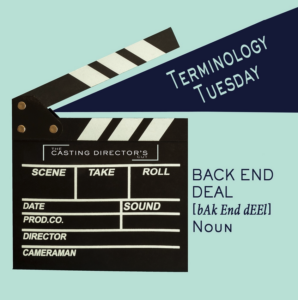 Today’s #terminologytuesday could be multiple blog posts long, but we’ll try our best to condense this down to the “what, why & how.”
Today’s #terminologytuesday could be multiple blog posts long, but we’ll try our best to condense this down to the “what, why & how.”
𝗪𝗛𝗔𝗧 𝗶𝘀 𝗮 𝗯𝗮𝗰𝗸 𝗲𝗻𝗱 𝗱𝗲𝗮𝗹?
A back end deal refers to an actor (or other creative professional) who agrees to take a deal (or points) on the back end—meaning that instead of only getting a flat fee, they also get a percentage of the profit that the project generates. Normally, taking a back end deal also means it reduces their upfront fee.
𝗪𝗛𝗬 𝘄𝗼𝘂𝗹𝗱 𝘀𝗼𝗺𝗲𝗼𝗻𝗲 𝗮𝘀𝗸 𝗳𝗼𝗿 𝗮 𝗯𝗮𝗰𝗸 𝗲𝗻𝗱 𝗱𝗲𝗮𝗹?
You might want to consider the option of a back end deal if you think the film will be successful, you’re passionate about the content and/or the creative team behind it, or, more commonly, if you really want to do a project but the production can’t afford your normal rate.
𝗛𝗢𝗪 𝗱𝗼𝗲𝘀 𝗶𝘁 𝘄𝗼𝗿𝗸 𝗲𝘅𝗮𝗰𝘁𝗹𝘆?
There are a few different types of back end deals:
1. Award-Winning Bumps: When an actor appears in a theatrically distributed film and the performer wins in the Best Actor/Actress category for a major awards show or film festival.
2. Back-end Bump: When an actor is contractually entitled to a one-time SAG scale bump in addition to the agreed-upon initial compensation.
3. Contingent Compensation: When an actor is contractually entitled to a one-time bonus payment depending on the producer’s share of the domestic box office profit.
4. Points: Points = percentages. So taking 1 point = 1%, 10 points = 10%, and so on. Points can be negotiated on the net scale or gross scale. Gross percentage = a higher return (more difficult to negotiate) while net percentages = a lower return (easier to negotiate).
Have you ever had a back end deal on a film? Comment below with your experience!
#themoreyouknow #terminologytuesday #thecastingdirectorscut #actorlife